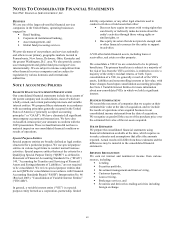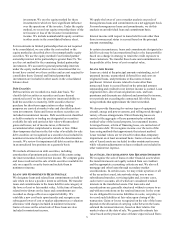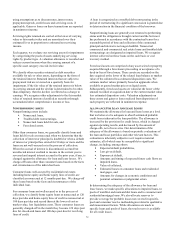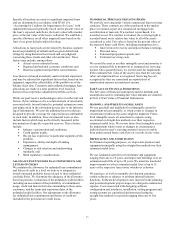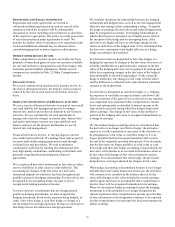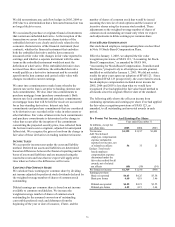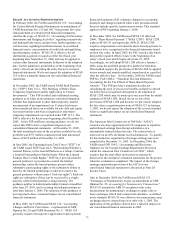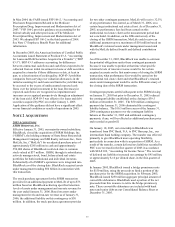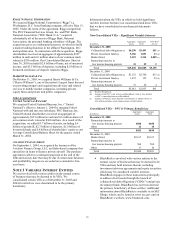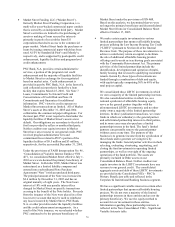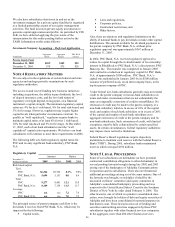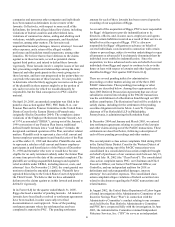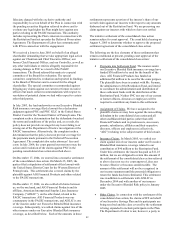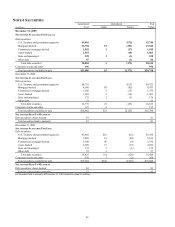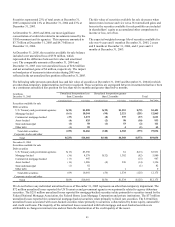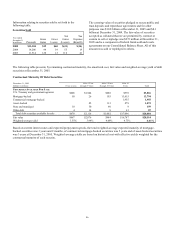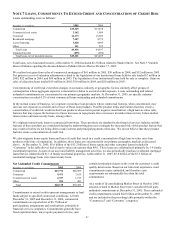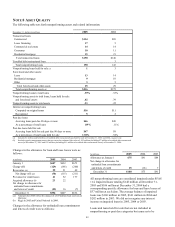PNC Bank 2005 Annual Report Download - page 79
Download and view the complete annual report
Please find page 79 of the 2005 PNC Bank annual report below. You can navigate through the pages in the report by either clicking on the pages listed below, or by using the keyword search tool below to find specific information within the annual report.79
• Market Street Funding LLC (“Market Street”),
formerly Market Street Funding Corporation, is a
multi-seller asset-backed commercial paper conduit
that is owned by an independent third party. Market
Street’ s activities are limited to the purchasing of
assets or making of loans secured by interests
primarily in pools of receivables from US
corporations that desire access to the commercial
paper market. Market Street funds the purchases or
loans by issuing commercial paper which has been
rated A1/P1 by Standard & Poor’ s and Moody’ s,
respectively, and is supported by pool-specific credit
enhancement, liquidity facilities and program-level
credit enhancement.
PNC Bank, N.A. provides certain administrative
services, a portion of the program-level credit
enhancement and the majority of liquidity facilities
to Market Street in exchange for fees negotiated
based on market rates. Credit enhancement is
provided in part by PNC Bank, N.A. in the form of a
cash collateral account that is funded by a loan
facility that expires March 25, 2010. See Note 7
Loans, Commitments To Extend Credit and
Concentrations of Credit Risk and Note 24
Commitments and Guarantees for additional
information. PNC views its credit exposure to
Market Street transactions as limited. All of Market
Street’ s assets at December 31, 2005 and 2004
collateralize the commercial paper obligations. For
the most part, PNC is not required to fund under the
liquidity facilities if Market Street’ s assets are in
default. Our obligations are secondary to the risk of
first loss provided by sellers or another third party.
Neither creditors nor equity investors in Market
Street have any recourse to our general credit. PNC
received program administrator fees and
commitment fees related to PNC’ s portion of the
liquidity facilities of $9.5 million and $3 million,
respectively, for the year ended December 31, 2005.
Under the provisions of FASB Interpretation No. 46,
“Consolidation of Variable Interest Entities (“FIN
46”), we consolidated Market Street effective July 1,
2003 as we were deemed the primary beneficiary of
Market Street. In October 2005, Market Street was
restructured as a limited liability company and
entered into a subordinated Note Purchase
Agreement (“Note”) with an unrelated third party.
The principal amount of the Note was increased to
$4.6 million by December 31, 2005 and has an
original maturity of eight years. The Note bears
interest at 18% with any penalty interest/fees
charged by Market Street on specific transactions
accruing to the benefit of the Note holder. Proceeds
from the issuance of the Note were placed in a first
loss reserve account that may be used to reimburse
any losses incurred by Market Street, PNC Bank,
N.A. or other providers under the liquidity facilities
and the credit enhancement arrangements. As a
result of the Note issuance, we reevaluated whether
PNC continued to be the primary beneficiary of
Market Street under the provisions of FIN 46R.
Based on this analysis, we determined that we were
no longer the primary beneficiary and deconsolidated
Market Street from our Consolidated Balance Sheet
effective October 17, 2005.
• We make certain equity investments in various
limited partnerships that sponsor affordable housing
projects utilizing the Low Income Housing Tax Credit
(“LIHTC”) pursuant to Section 42 of the Internal
Revenue Code. The purpose of these investments is to
achieve a satisfactory return on capital, to facilitate
the sale of additional affordable housing product
offerings and to assist us in achieving goals associated
with the Community Reinvestment Act. The primary
activities of the limited partnerships include the
identification, development and operation of multi-
family housing that is leased to qualifying residential
tenants. Genera lly, these types of investments are
funded through a combination of debt and equity,
with equity typically comprising 30% to 60% of the
total project capital.
We consolidated those LIHTC investments in which
we own a majority of the limited partnership interests.
We also consolidated entities in which we, as a
national syndicator of affordable housing equity,
serve as the general partner (together with the
aforementioned LIHTC investments), and no other
entity owns a majority of the limited partnership
interests. In these syndication transactions, we create
funds in which our subsidiary is the general partner
and sells limited partnership interests to third parties,
and in some cases may also purchase a limited
partnership interest in the fund. The fund’ s limited
partners can generally remove the general partner
without cause at any time. The purpose of this
business is to generate income from the syndication of
these funds and to generate servicing fees by
managing the funds. General partner activities include
selecting, evaluating, structuring, negotiating, and
closing the fund investments in operating limited
partnerships, as well as oversight of the ongoing
operations of the fund portfolio. The assets are
primarily included in Other assets on our
Consolidated Balance Sheet. Neither creditors nor
equity investors in the LIHTC investments have any
recourse to our general credit. The consolidated
aggregate assets and debt of these LIHTC investments
are provided in the Consolidated VIEs – PNC Is
Primary Beneficiary table and reflected in the
Corporate & Institutional Banking business segment.
We have a significant variable interest in certain other
limited partnerships that sponsor affordable housing
projects. We do not own a majority of the limited
partnership interests in these entities and are not the
primary beneficiary. We use the equity method to
account for our investment in these entities.
Information regarding these partnership interests is
reflected in the Non-Consolidated VIEs – Significant
Variable Interests table.


